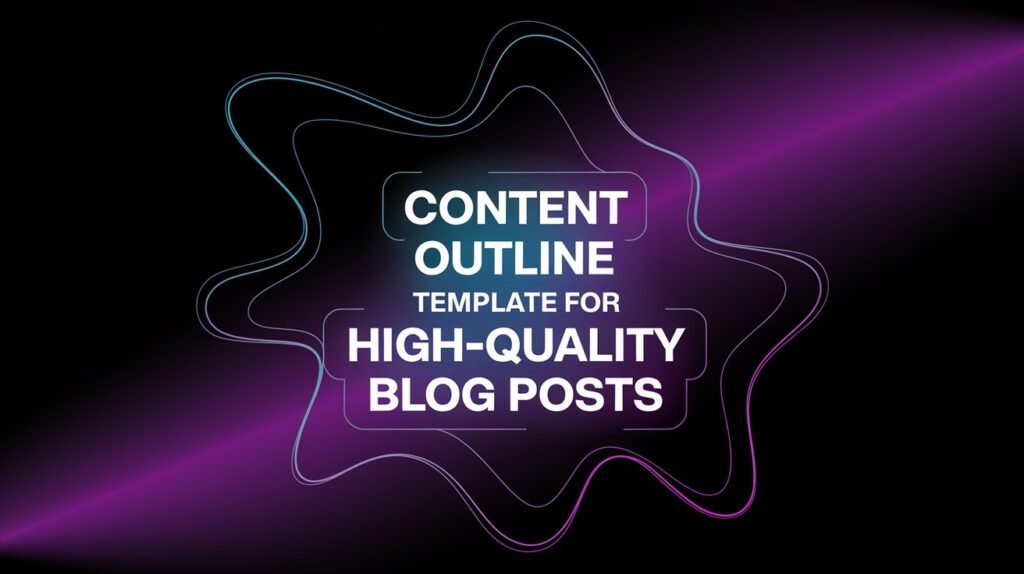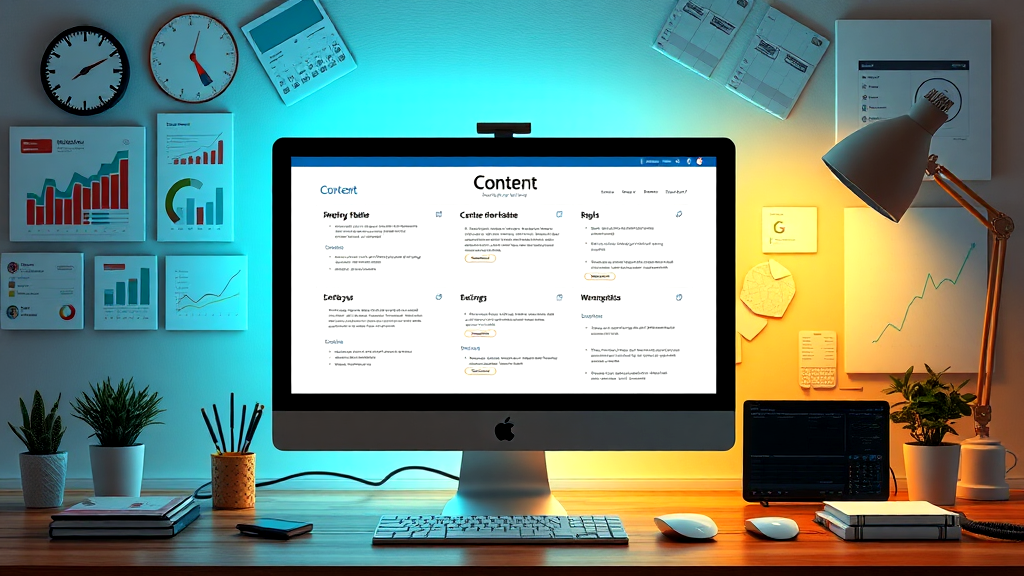
Creating a content outline is crucial for producing great content. It helps you organize your thoughts and ensures you include all relevant elements, like keywords and search intent. This content outline template will guide you through crafting a well-structured piece that is both informative and engaging.
With a clear outline, you save time and enhance your writing efficiency. Whether you’re targeting SEO or aiming for reader engagement, a solid outline lays the groundwork. Plus, using tools like Surfer SEO can elevate your outlining game. By the end of this post, you’ll have the tools to create perfect content outlines that resonate with your audience and rank well on search engines.
Key Takeaways
A content outline streamulates your writing. It helps organize thoughts clearly and efficiently.
Define your article’s purpose and grasp search intent. This keeps your content focused.
Use SEO keywords and tools like Surfer SEO for better visibility in search engines.
Include relevant examples and data. This builds trust and keeps readers engaged.
Download a content outline template to streamline your outlining process for a great content outline.

Understanding Content Outlining
Grasping the concept of content outlining is crucial for successful writing. A content outline serves as your roadmap, guiding you through each section. It ensures that every piece of content flows logically and covers all necessary points.
When creating content outlines, start by defining your goals. Are you informing, persuading, or entertaining? Next, identify your target SEO keywords. Tools like Surfer SEO can help you find relevant keywords that match search intent.
Organize your outline with clear headings and subheadings. This makes your content readable and SEO-friendly. Don’t forget to include examples and data to support your claims. Finally, consider using a content outline template to streamline the process and enhance your writing efficiency.

Importance of a Content Outline
A solid content outline plays a crucial role in your writing journey. It helps you maintain direction and clarity while crafting your piece. By organizing your thoughts, you can ensure that every section aligns with your main objective, whether to inform or entertain.
When using a content outline template, you can seamlessly incorporate essential SEO elements. This structured approach not just boosts your content’s quality but also keeps you on track. The clarity gained from an outline allows you to avoid information overload and confusion while writing.
Creating content outlines streamulates the writing process, enabling you to deliver a piece of content that resonates with readers. This method ensures you include necessary keywords, data, and examples, elevating your overall piece. By prioritizing a thorough outline, you enhance both the writing experience and the finished product.

Creating an Effective Content Outline
Establishing an effective outline makes all the difference in your writing. Start by defining your article’s goal. Every section should align with this purpose. Next, select a keyword to guide your SEO efforts. Tools like Surfer SEO can help identify the right terms.
Understanding search intent is crucial. Analyze top content to see what resonates with readers. Structure your outline with clear headings and subheadings, making it easy to follow. Create a working title that incorporates your target keyword and piques interest.
Incorporate relevant examples and data to enhance credibility. Specify word counts to keep your writing focused. Long-tail keywords can support your primary choice and boost visibility. Lastly, using a content outline template can streamline the process, ensuring you cover all critical components.

Define Your Article’s Purpose
Setting a clear objective for your article is crucial. This clarity ensures that each section aligns with the overall intent. Whether you aim to inform, persuade, or entertain, a defined purpose keeps your writing focused.
Think about what you want your readers to take away. Are you providing solutions, sharing insights, or sparking curiosity? Each part of your piece should contribute to this goal.
Using a content outline template helps in structuring your thoughts. This way, you can easily see how each element supports your purpose. Don’t forget to include relevant keywords to enhance SEO.
Before diving into writing, clarify your message. A well-defined purpose not just guides you but also resonates with your audience. It’s like having a roadmap; it shows you where to go and helps you stay on track.
Choose an SEO Keyword
Selecting the right keyword is a game-changer for your SEO content outline. Focus on relevance and search volume to ensure your content resonates with users. Use tools like Surfer SEO to pinpoint effective keywords that align with your topic.
Consider variations and long-tail keywords too; they attract specific searches and enhance your visibility. Analyze competitors to see what keywords they rank for. This gives insight into successful strategies.
As you identify your keyword, think about user intent. What information do they expect? This understanding shapes your content direction.
Finally, integrate your chosen keyword naturally throughout your piece. Aim for a seamless flow rather than forced inclusion. This balance keeps your writing engaging while optimizing for search engines. With a strategic approach, your piece of content will stand out and rank higher.

Grasp the Search Intent
Understanding user motivation is critical for successful content creation. When you analyze what prompts users to search for a keyword, you can craft content that meets their needs. Look at the top-ranking articles and observe their angles.
This analysis reveals what information users find valuable. When you align your article with user expectations, engagement naturally increases.
Utilize tools like Surfer SEO to refine your approach. These resources help evaluate what works in existing content.
By doing so, you can create an effective SEO content outline that resonates with your audience. The right outline not just organizes your thoughts, but also positions your piece of content for better visibility. Always remember, clarity in purpose leads to clarity in writing.
Keep this in mind as you develop your content outlines.
Structuring Your Content Outline
When you’re structuring your content outline, organization is key. Start by using a clear hierarchy of headings and subheadings. This not just helps readability but also signals to search engines what’s important.
Next, brainstorm a compelling title that includes your keyword. This draws readers in and aligns with their search intent.
Consider incorporating relevant examples and data to bolster your claims. These elements enhance credibility and keep your audience engaged.
Specify the desired word count within your outline. This helps you determine the depth of each section.
Finally, utilize tools like Google Doc for collaboration and updates. Having a content outline template ready to go saves time and ensures you cover all essential elements efficiently.

Organize with Headings and Subheadings
Using headings and subheadings is key to crafting a clear structure for your writing. They help guide your readers through the flow of your ideas. You can create a content outline that highlights main topics while breaking them into manageable sections.
Each heading should capture the essence of the content beneath it. This makes it easier for your audience to scan and find what they need. Subheadings provide further detail, making your piece of content more digestible.
A well-organized outline not just aids your writing process but also enhances SEO. Search engines favor structured content, so be sure to use relevant keywords in your headings. This strategy can improve your ranking and visibility. By following these tips, you’ll improve both readability and engagement in your articles, making them more appealing to your audience.
Develop a Working Title
Creating a compelling title is crucial for capturing audience interest and aligning with search intent. When brainstorming, consider variations that include your target keyword. Aim for clarity and engagement.
To generate ideas, jot multiple options on a Google Doc. Experiment with phrasing and tone until you find a title that resonates. Use strong action words and emotional triggers.
For example, instead of “Tips for Writing,” try “Unlock Your Writing Potential with These Expert Tips.”
Remember, a catchy title can make your piece of content stand out in search results. Also, ensure it reflects the core theme of your article.
Keep testing different combinations until you hit the mark. A great title sets the tone for your entire article, enhancing both reader engagement and SEO performance.

Use SEO Tools like Surfer SEO or NeuronWriter
Utilizing tools like Surfer SEO and NeuronWriter can vastly improve your outlining process. These resources offer insights into top-ranking articles, helping you pinpoint essential keywords and structural elements.
By analyzing competitors, you can identify what works well and what doesn’t. This ensures that your content outline aligns with search intent, making it more effective.
Think of SEO tools as your writing assistants. They help you create a more organized and comprehensive outline, ultimately leading to a stronger piece of content.
Harnessing these insights can enhance your productivity while ensuring that your content remains relevant and engaging. Plus, you’ll minimize the risks of duplicate content, which can hurt your rankings.
Incorporate these suggestions into your content outline template, and you’ll be on your way to crafting quality posts that resonate with your audience.
Content Outline Elements
Incorporating key components into your content outline is crucial for effective writing. Focus on these elements to enhance your content outline template:
Clear Objectives: Define what you want to achieve with your content.
Target Audience: Identify who you’re writing for and tailor your message accordingly.
Relevant Examples: Use data and anecdotes to support your points.
Specific Word Count: Indicate the desired length for each section to maintain focus.
Keyword Strategy: Include primary and long-tail keywords for better SEO visibility.
Subheadings: Organize information with headings and subheadings for easy navigation.
Visual Elements: Plan for images, infographics, or charts that complement your text.
By integrating these components, you enhance clarity and engagement in your writing process. This leads to more compelling pieces of content that resonate with your audience.

Include Relevant Examples and Data
Supporting your claims with data and examples enhances credibility and engagement. When you include statistics, studies, or real-life anecdotes, your content becomes more persuasive. For instance, citing a recent survey showing that 75% of users prefer data-driven articles can boost your authority.
Using tools like Google Docs makes it easier to insert these elements seamlessly.
Additionally, mentioning notable figures such as Deb Mukherjee can add weight to your arguments. Highlight how their insights relate to your subject. Statistics can effectively illustrate trends or demonstrate the impact of certain practices.
Incorporating these strategies into your content outline template ensures your writing is not just informative but also compelling. Your audience will appreciate the depth and relevance that solid examples and data provide.
Specify Word Count and Content Type
The focus on word count and content type is crucial for effective content creation. Tailoring the word count aligns with the content outline you’re working on. For example, blog posts typically range from 800 to 1,500 words, while in-depth articles may require more. Adjusting the count ensures you cover your topic comprehensively without overwhelming readers.
When considering content type, think about what best suits your audience. Informative articles, how-to guides, and listicles each have different expectations. A well-structured content outline template can help you specify these elements clearly. Using this approach, you can effectively plan and execute your writing projects. Ultimately, balancing word count with the right content type will enhance reader engagement and improve SEO performance.

Optimize with Long-Tail Keywords
Incorporating long-tail keywords can significantly boost your content’s performance. These keywords help support your primary keyword, making your writing more discoverable. They often reflect specific user queries, which can lead to higher conversion rates.
When creating content outlines, sprinkle long-tail keywords naturally throughout your sections. This approach ensures your writing aligns with what users are searching for while enhancing the overall flow of your piece. For example, instead of just focusing on “content outline,” consider phrases like “how to create a content outline template” or “examples of effective content outlines.”
Using tools like Google Docs can streamline this process, allowing for easy collaboration and adjustments. By focusing on these strategic phrases, you’re setting your piece of content up for success in search engine rankings.
Content Outline Template Example
Looking for a content outline template? Here is an example temate you can use:
-
Title/Headline:
- Compelling and keyword-rich title that accurately reflects the blog post content.
-
Introduction:
- Hook to grab the reader’s attention.
- Brief overview of the topic and main points to be discussed.
- Establish credibility and relevance to the audience.
-
Body Sections (with clear subheadings):
- Point 1:
- Detailed explanation of the first key point.
- Supporting evidence (statistics, expert opinions, case studies).
- Relevant examples to illustrate the concept.
- Point 2:
- Same structure as point 1, addressing the next key aspect of the topic.
- [Continue with additional points as needed, maintaining a logical flow]
- Point 1:
-
Conclusion:
- Summarize the main takeaways from the blog post.
- Reiterate the key points.
- Include a clear call-to-action (CTA) – what you want the reader to do next (subscribe, share, comment, etc.).
-
Visuals:
- Relevant images, infographics, or videos to break up text and enhance understanding.
-
Related Content:
- Internal links to other relevant blog posts on your site.
- External links to credible sources for further reading.
-
SEO Optimization:
- Include target keywords naturally throughout the text.
- Optimize meta descriptions and title tags for search engines.
Example Blog Post Outline (Topic: “How to Improve Your Sleep Quality”):
-
Title:“7 Simple Habits to Transform Your Sleep Quality Tonight”
-
Introduction:
- Highlight the importance of good sleep for overall health and wellbeing.
- Briefly discuss the common sleep disruptions people face.
-
Body Sections:
- Section 1: Establish a Consistent Sleep Schedule:
- Explain the benefits of a regular sleep routine.
- Provide tips on setting consistent bedtimes and wake-up times, even on weekends.
- Section 2: Optimize Your Bedroom Environment:
- Discuss the ideal room temperature, lighting, and noise level for sleep.
- Highlight the importance of a comfortable mattress and bedding.
- Section 3: Wind Down Before Bedtime:
- Suggest calming activities to prepare for sleep (e.g., reading, taking a warm bath).
- Explain the negative impacts of screen time before bed.
- Section 1: Establish a Consistent Sleep Schedule:
-
Conclusion:
- Recap the key strategies for improving sleep quality.
- Encourage readers to implement these changes gradually and monitor their sleep patterns.
- CTA: “Share your favorite sleep habits in the comments below!”

Building Quality Content with Outlining
Creating quality content hinges on effective outlining. A content outline template organizes your ideas and streamlining the writing process. It helps ensure you include all necessary elements, enhancing clarity and focus.
By defining your article’s purpose upfront, you can guide your writing. Be clear about your goals, whether to inform or entertain. Selecting relevant keywords, like long-tail variations, makes your piece of content more discoverable.
Incorporate supporting data and examples to bolster your claims. This not just improves engagement but also lends credibility.
Ultimately, a solid outline prevents confusion and keeps your writing on track. It’s a roadmap that leads to a more polished final product. A well-structured outline is your ally in crafting exceptional content that resonates with readers and ranks well in searches.

Conclusion
Creating a content outline is more than just a helpful tool; it’s a roadmap for your writing journey. When you define your article’s purpose and select your keywords effectively, you set the stage for a smoother writing process. Each section you outline serves a specific purpose, guiding you toward a well-structured and engaging piece.
Moreover, incorporating examples and specifying word counts enhances clarity and focus. This approach not just organizes your thoughts but also boosts your SEO efforts. With a solid outline, you’re well-prepared to craft content that resonates with readers while satisfying search engine algorithms. Embrace this method, and watch your writing flourish!
FAQ
What is a content outline template?
A content outline template is a structured plan for organizing your blog post. It includes headings, subheadings, and key points. This helps you stay focused and ensures you cover all necessary topics.Why is a content outline important?
A content outline helps improve writing efficiency and SEO performance. It keeps your writing focused and organized, making it easier to create high-quality content. With a clear outline, you can scale your writing while maintaining quality.How do I create an effective content outline?
To create an effective outline, start by defining your article’s purpose. Next, select an SEO keyword and understand the search intent. Organize your content using headings and subheadings to maintain clarity.What elements should I include in my content outline?
Include relevant examples, data, and a specified word count. Don’t forget to optimize with long-tail keywords. These elements will enhance credibility and ensure thorough coverage of your topic.Where can I download a content outline template?
You can find downloadable content outline templates online. Many resources offer templates that include essential components to streamline your outlining process. These can be tailored to your specific needs.
Recent Posts
Affiliate Offer Goldmine: How I Find Profitable Affiliate Offers
Affiliate marketing can be overwhelming if you rely on guesswork or follow generic advice. I've discovered that most beginners waste time promoting overcrowded, untested, or unprofitable offers. In...
As an affiliate marketer, you know how crucial it is to create engaging and effective blog posts that drive traffic and generate sales. But coming up with fresh and profitable ideas can be a...

